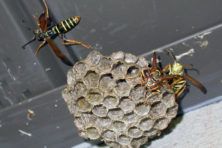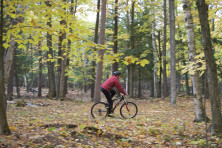Jewel Wasps and Obese Mothers
- Share
- Tweet
- Pin
- Share
• Polar bears are among the most majestic and mysterious mammals in the world. Considering the increasing loss of arctic sea ice, concerns have been raised about their future. The best data indicate that 20,000 to 25,000 polar bears exist today distributed in 19 discrete populations. Three populations are stable, eight are decreasing, and little is known about the rest (mostly in Russia). The long-term impact of global warming on these bears is yet unknown. On one hand, DNA analysis shows that they have been on the planet for over 600,000 years, so their ancestors experienced climate changes over thousands of years of evolution. On the other hand, what is happening today suggests that polar bears have to swim farther and work harder for their food. Researchers tracked 52 radio-collared polar bears in the Beaufort Sea. A third of the bears swam more than 31 miles looking for food, and one female swam 217 miles over nine days. She lost 22% of her body mass—and her cub drowned. (Science Magazine, April 20, 2012; Canadian Journal of Zoology, May, 2012; The Economist, June 16th, 2012)
• Reproductive behavior in the Jewel Wasp (Ampulex compressa) of South Asia, Africa, and the Pacific Islands stretches our imagination. The female wasp finds a cockroach and uses its stinger to inject venom into a particular part of the roach’s nerve cord. This reversibly paralyzes the roach’s front legs. The wasp then proceeds to inject venom into the roach’s brain—not enough to kill the roach, but enough to block its escape reflex. The roach is now an insect version of a zombie. Next the wasp chews off half the roach’s two antennae, grabs one of them, and slowly leads the roach to its burrow, as one might lead a dog on a leash. The wasp proceeds to lay one egg, about 2 mm long, on the roach’s abdomen, after which it fills the entrance to the burrow to keep predators away and ensure that the roach cannot leave. After a few days, the wasp larva hatches from the egg and chews its way into the abdomen of the roach, where it begins to feed on the roach’s internal tissues. By this time the roach is dead, but the larva prevents rotting or putrefaction of the “meat” inside the roach by secreting a substance over the internal organs that kills bacteria that might cause spoilage. Ultimately the larva forms a cocoon inside what is left of the roach’s body, and after a few days it digs its way out and emerges as a young adult wasp. (Science News, Jan. 26, 2013; Meinwald, J., 2012, Proc. of the Nat. Academy of Sciences, Dec., 2012; http://www.wikipedia.org)
• Do obese mothers tend to have autistic children? Researchers examined the pregnancy history of 1,004 obese mothers and followed their offspring until about seven years of age. Differences in race, geographical region, mother’s age, and date of birth were all accounted for. These obese mothers had 315 normal children, but they had 517 children with autism behavior syndrome, and 172 with developmental delays. The data indicate that obese mothers were more likely to have an autistic child than healthy mothers of normal weight. (Krakswiak, C., et al, 2012, Pediatrics, May 1 issue; Science News, May 19, 2012)


